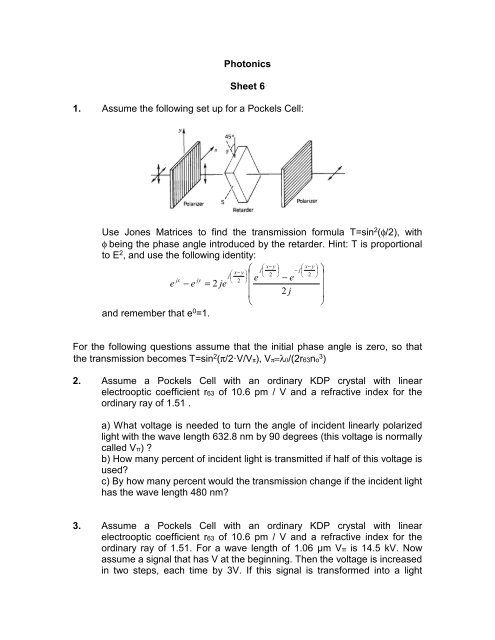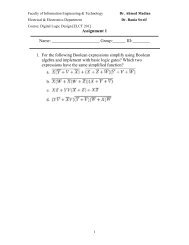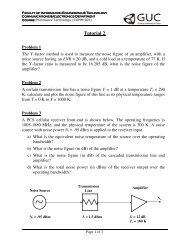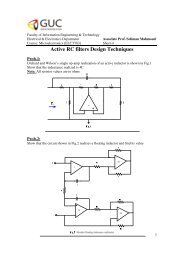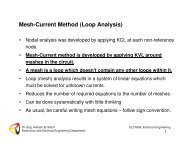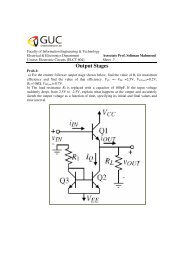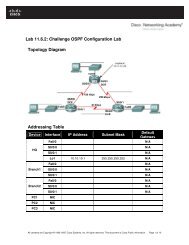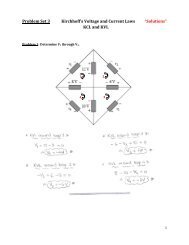Homework 6
Homework 6
Homework 6
Create successful ePaper yourself
Turn your PDF publications into a flip-book with our unique Google optimized e-Paper software.
Photonics<br />
Sheet 6<br />
1. Assume the following set up for a Pockels Cell:<br />
Use Jones Matrices to find the transmission formula T=sin 2 (φ/2), with<br />
φ being the phase angle introduced by the retarder. Hint: T is proportional<br />
to E 2 , and use the following identity:<br />
e<br />
− e<br />
and remember that e 0 =1.<br />
jx<br />
jy<br />
= 2 je<br />
⎛ x−<br />
y ⎞<br />
j⎜<br />
⎟<br />
⎝ 2 ⎠<br />
⎛<br />
⎜ e<br />
⎜<br />
⎜<br />
⎝<br />
⎛ x−<br />
y<br />
j⎜<br />
⎝ 2<br />
⎞<br />
⎟<br />
⎠<br />
− e<br />
2 j<br />
⎛ x−<br />
y<br />
− j⎜<br />
⎝ 2<br />
⎞<br />
⎟<br />
⎠<br />
⎞<br />
⎟<br />
⎟<br />
⎟<br />
⎠<br />
For the following questions assume that the initial phase angle is zero, so that<br />
the transmission becomes T=sin 2 (π/2·V/Vπ), Vπ=λ0/(2r63no 3 )<br />
2. Assume a Pockels Cell with an ordinary KDP crystal with linear<br />
electrooptic coefficient r63 of 10.6 pm / V and a refractive index for the<br />
ordinary ray of 1.51 .<br />
a) What voltage is needed to turn the angle of incident linearly polarized<br />
light with the wave length 632.8 nm by 90 degrees (this voltage is normally<br />
called Vπ) <br />
b) How many percent of incident light is transmitted if half of this voltage is<br />
used<br />
c) By how many percent would the transmission change if the incident light<br />
has the wave length 480 nm<br />
3. Assume a Pockels Cell with an ordinary KDP crystal with linear<br />
electrooptic coefficient r63 of 10.6 pm / V and a refractive index for the<br />
ordinary ray of 1.51. For a wave length of 1.06 µm Vπ is 14.5 kV. Now<br />
assume a signal that has V at the beginning. Then the voltage is increased<br />
in two steps, each time by 3V. If this signal is transformed into a light
signal by the desribed Pockels Cell, what would be the signal change in %<br />
(in relation to the 3V-Intensity) at each step<br />
4. Assume a Pockels Cell with an ordinary KDP crystal with linear<br />
electrooptic coefficient r63 of 10.6 pm / V and a refractive index for the<br />
ordinary ray of 1.51 . For a wave length of 1.06 µm Vπ is 14.5 kV.<br />
Calculate the voltage where the intensity curve shows linear behaviour. In<br />
what voltage range do you find linear behaviour if you assume that a<br />
change in the slope of 10% is still linear<br />
5. Assume a Pockels Cell with an ordinary KDP crystal with linear electrooptic<br />
coefficient r63 of 10.6 pm / V, a refractive index for the ordinary ray of 1.51, and<br />
for a wave length of 1.06 µm Vπ is 14.5 kV.<br />
a) Calculate the voltage for the “point” where the “intensity curve shows<br />
linear behaviour” for the described Pockels Cell (see question 4).<br />
b) Calculate the linear function that describes a tangent line that passes<br />
through the point calculated in question a) and which has the same slope as<br />
the intensity curve in that point.<br />
c) Now it should be found out in what voltage range the described Pockels<br />
Cell can be used as a linear modulator. Because of the symmetry of the<br />
problem it is sufficient to calculate only the lower voltage value of this<br />
range. If we assume that the intensity curve can be considered linear if the<br />
difference between the tangent of question b) and the original intensity curve<br />
is below 0.1, what is then the lower limit of the voltage range<br />
Hint: Because the function f(V) you will obtain in order to answer the question is<br />
not solvable by standard means, use the Newton-Method to find the solution<br />
(i.e. to solve the function f(V) = 0 for V):<br />
V<br />
n+<br />
1<br />
= V<br />
n<br />
−<br />
f ( Vn<br />
)<br />
f ′(<br />
V )<br />
n<br />
Use V = 900 Volts as a start value, and stop when f(Vn) gets below 0.001 (or<br />
after 3 iterations).<br />
The intensity curve’s function values are (in the here interesting range)<br />
greater than the tangent’s function values; the derivative of the function f(V)<br />
you will have to solve has in the here interesting range only negative function<br />
values; if the function values of the derivative of f(V) get below a value of -0.0001,<br />
you can assume that the function values of the derivative do not change<br />
anymore and take -0.0001 as the value for the function value of the derivative,<br />
it is then not necessary anymore to calculate the function values of the<br />
derivative.


